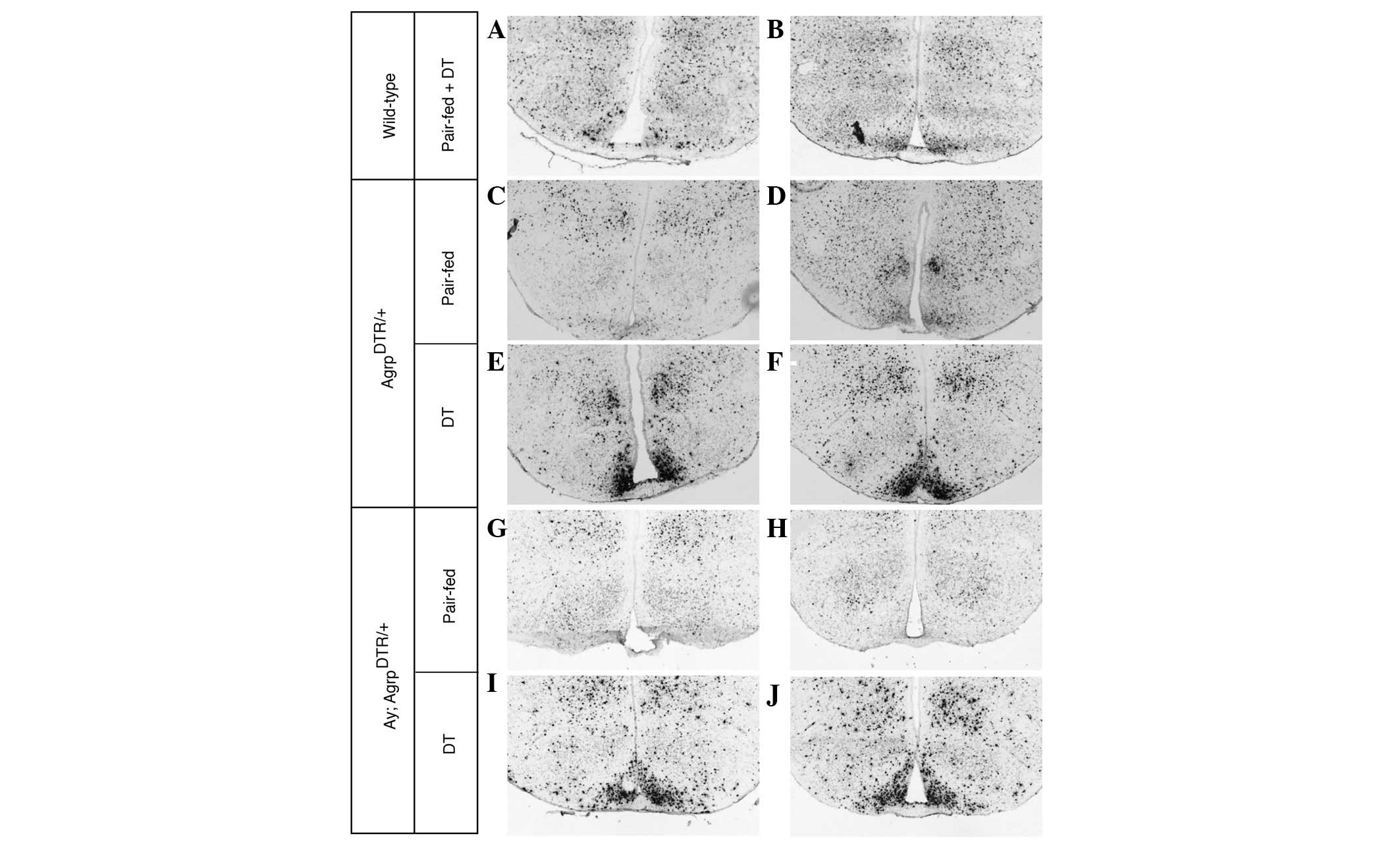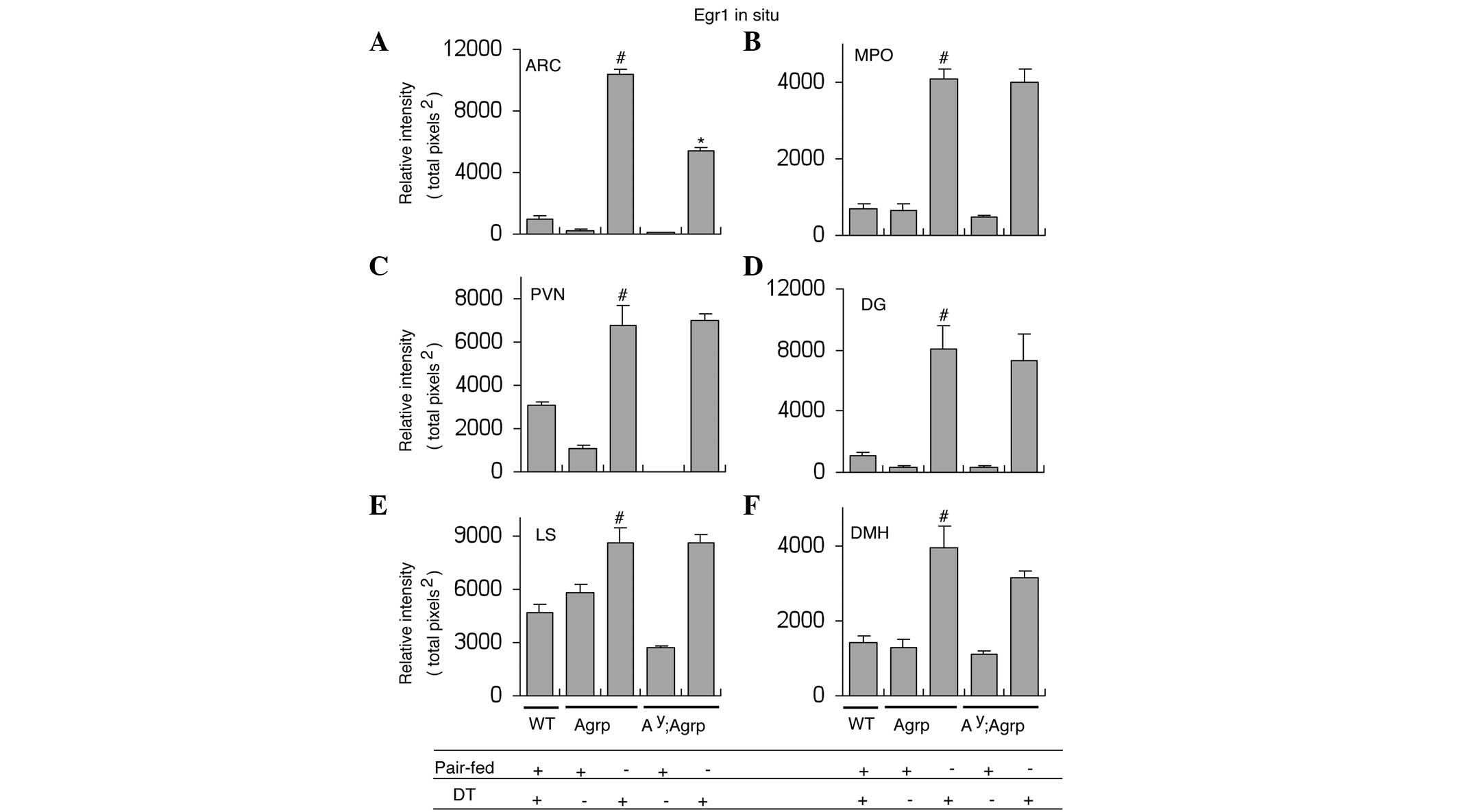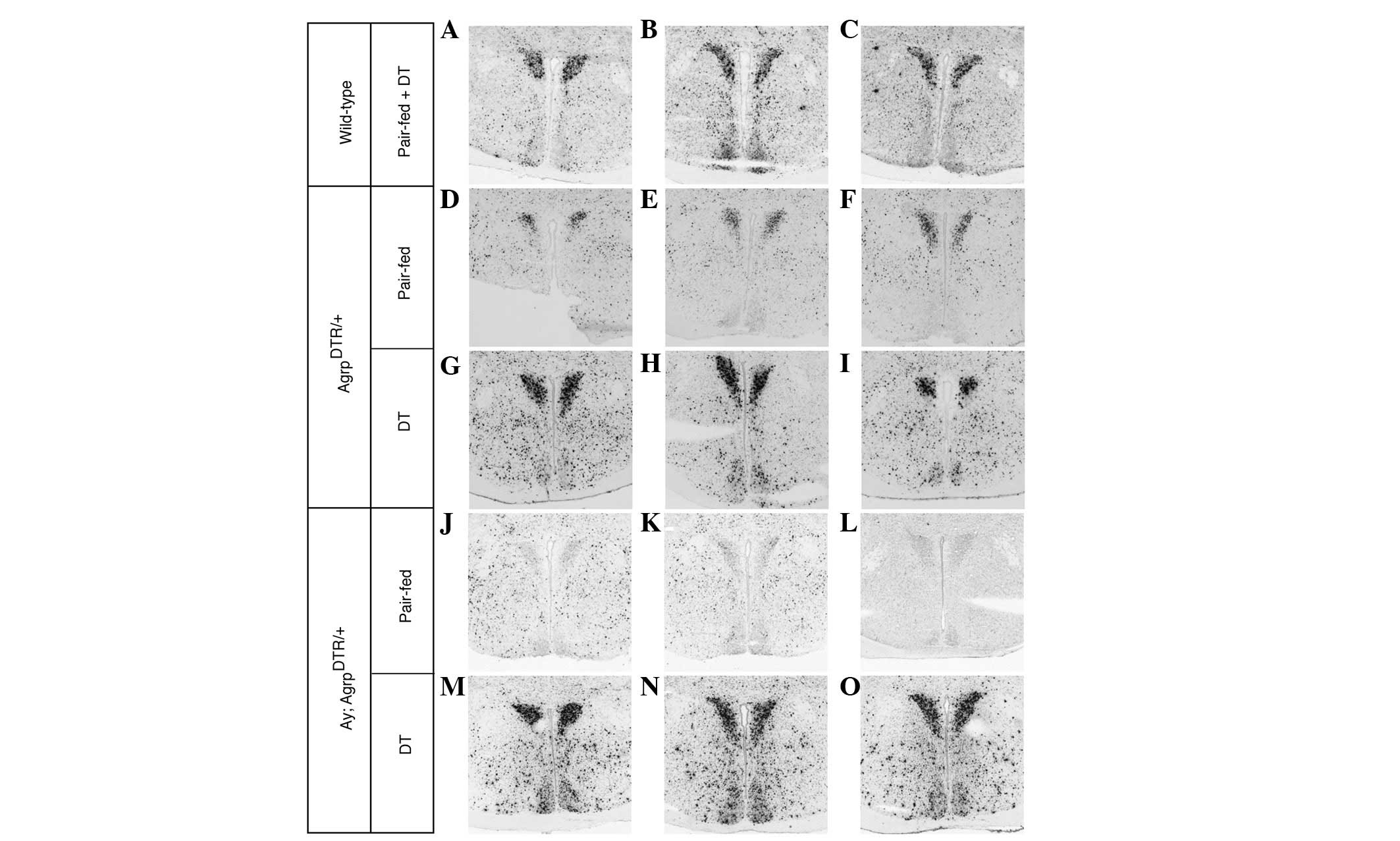Functional profiling of immediate early gene Egr1 in an anorexic mouse model
- Authors:
- Published online on: August 28, 2013 https://doi.org/10.3892/mmr.2013.1656
- Pages: 1563-1569
Abstract
Introduction
Agouti-related protein (ARP) is an orexigenic peptide that modulates appetite and energy balance (1). ARP-expressing neurons also produce neuropeptide Y (NPY) and the inhibitory neurotransmitter GABA (2,3). ARP stimulates robust feeding behavior when injected into the 3rd ventricle or directly into the paraventricular nucleus (PVN) or dorsomedial hypothalamic nucleus (DMH) (1,4). Its mRNA level increases in the arcuate nucleus (ARC) under starvation conditions, as well as in obese animals deficient in leptin signaling (5–8). Several groups have devised strategies whereby ARP neurons are ablated to investigate their involvement in body weight regulation (9–12). One such strategy has been used in adult mice and has demonstrated that ARP neuron ablation leads to the inhibition of feeding behavior (10). In this ablation technique, diphtheria toxin receptors (DTR) were targeted under the control of the Agrp promoter to ensure exclusive expression of DTR in ARP neurons (9,10). Diphtheria toxin (DT) was then administered to adult mice, leading to the ablation of the neurons over the next few days. This treatment led to a significant loss of body weight and the mice were shown to have developed anorexia (9,10). Studies have suggested that ablation of ARP neurons removes NPY and GABA-mediated inhibition of postsynaptic neurons, leading to hyperexcitation of selected downstream brain regions and the induction of starvation behavior (13). However, the cellular mechanism underlying the excitability of postsynaptic neurons in response to ablation of ARP neurons is poorly understood.
The immediate early gene, early growth response factor-1 (Egr1), is a transcription factor that regulates transcriptional responses to cell stimulation in a variety of neurons and other cells. It is rapidly induced by stimuli, such as growth factors or cell depolarization (14,15). Constitutive expression of Egr1 has been identified in certain types of neurons (16). In vagal afferent neurons, it has been demonstrated that cholecystokinin (CCK) stimulates the redistribution of Egr1 to the nucleus, and leptin stimulates Egr1 expression (17). Egr1 induces the expression of the gene encoding the satiety neuropeptide, cocaine- and amphetamine-regulated transcript (CART), in the nodose ganglion, which leads to the inhibition of food intake (17).
The present study aimed to determine the functional association between appetite-controlling ARP neurons and Egr1 in postsynaptic neurons. Egr1 expression levels were investigated in different brain regions following acute ablation of ARP neurons. As ARP neurons promote appetite in part through inhibiting the pro-opiomelanocortin (POMC) pathway (2,3,18), it was also investigated whether blockade of melanocortin signaling affects Egr1 expression in ARP neuron-ablated mice. It was demonstrated that the death of ARP neurons was associated with robust activation of Egr1 expression in selected brain regions. In addition, it was suggested that Egr1 may induce a novel signaling cascade in postsynaptic neurons that mediates the feeding response and energy balance.
Materials and methods
Animal maintenance
Mice were housed in a temperature- and humidity-controlled environment with a 12-h light/dark cycle. All experimental protocols and animal handling procedures were performed according to the protocol approved by the Institutional Animal Care and Use Committee of the Central South University (Changsha, China). AgrpDTR mice and Ay mice were obtained from the Jackson Laboratory (Bar Harbor, ME, USA). The AgrpDTR mice were generated by targeting a human DTR cDNA to the Agrp locus of mice to allow the selective killing of ARP neurons in adult mice by administration of DT. Administration of DT resulted in reliable loss of food consumption and body weight (9,10). The Ay mice express agouti protein ectopically in virtually all tissues, including the brain (19). Agouti protein antagonizes the action of α-melanocyte stimulating hormone (α-MSH) binding to melanocortin 4 receptors (MC4Rs) and thus prevents melanocortin signaling via Gαs-coupled receptors on postsynaptic cells (18). AgrpDTR mice and Ay mice were mated together to generate Ay; AgrpDTR/+ mice. The Ay; AgrpDTR/+ mice were generated to determine the consequence of suppressed melanocortin signaling on Egr1 gene induction. The yellow mice derived from this cross comprise were the Ay; AgrpDTR/+ group, whereas the black littermates served as AgrpDTR/+ controls. Mice were group-housed with a standard chow diet and water ad libitum until the beginning of the experiments. To ablate ARP neurons, systemic injection of DT (two injections of 50 mg/kg; Sigma Aldrich, St. Louis, MO, USA) was performed in 9-week-old mice (9,10).
In situ hybridization
Brains were sectioned (coronal, 25 μm thickness) and used for in situ hybridization with Egr1 probes according to the manufacturer’s instructions (Roche, Mannheim, Germany). Materials and detailed procedures concerning the data generation process (riboprobe production, in situ hybridization, image capture and processing) have been described previously (20). Briefly, an antisense Egr1 oligonucleotide probe was used for in situ hybridization. Tissue sections were postfixed in 4% formaldehyde/phosphate-buffered saline (PBS), rinsed in PBS and acetylated in 0.25% acetic anhydride/0.1 M triethanolamine. Hybridization in a solution containing a saturating concentration (~28 kcpm/μl) of radiolabeled probe was conducted at 65°C for 18 h. Coverslips were removed in 4X standard sodium citrate and non-specifically bound probe was removed by treatment with RNase (Sigma-Aldrich) for 30 min. Sections were run through stringency washes of 1X saline sodium citrate (SSC) buffer and 0.5X SSC at 37°C and 0.1X SSC at 42°C. Sections were then dehydrated, air-dried and exposed to Kodak BioMax X-ray film (Kodak Inc., Rochester, NY, USA) for 3 days along with microscale 14C standards (GE Healthcare, Little Chalfont, UK).
Statistical analysis
Quantification of Egr1-positive cells was conducted using ImageJ software (National Institutes of Health, Bethesda, MA, USA). Anatomical correlations of brain sections and delineation of individual nuclei were determined by comparing landmarks of Nissl staining images with those provided in the Paxinos stereotaxic atlas (21). From the anatomically matched sections, a region of interest of the same size was further defined. In addition, an optimized threshold that discerns round Egr1-positive nuclei from partially stained ones and background noise was preset for all measurements. The total number of pixels of Egr1-positive cells inside the defined region was recorded. Unless otherwise stated, data were analyzed using one-way analysis of variance followed by a post-hoc Student-Newman-Keuls test. Data are presented as the mean ± SEM. P<0.05 was considered to indicate a statistically significant difference.
Results
Ablation of ARP neurons by administration of DT induces Egr1 in the ARC
A human DTR cDNA was targeted to the Agrp locus of mice, which allowed the selective killing of ARP neurons in adult mice by administration of DT. Administration of DT has been shown to result in reliable loss of food consumption and body weight (9,10). The cell bodies of all ARP neurons located in the ARC were shown to be completely ablated by DT treatment (9,10). In situ hybridization showed that Egr1 expression was robustly induced in the ARC of AgrpDTR mice following DT treatment (Fig. 1E and F, and Fig. 2A). In contrast, DT treatment in wild type (WT) and pair-fed mice exhibited no effect on Egr1 expression (Fig. 1A–D and Fig. 2A).
Induction of Egr1 in the ARC is attenuated in the absence of melanocortin signaling
The Ay mice express agouti protein ectopically in virtually all tissues, including the brain (19). Agouti protein antagonizes the action of α-MSH binding to MC4R, and thus prevents melanocortin signaling via the Gαs-coupled receptors on postsynaptic cells (18). AgrpDTR mice and Ay mice were mated together to generate Ay; AgrpDTR/+ mice. Ay; AgrpDTR/+ mice were generated to determine the consequence of suppressed melanocortin signaling on Egr1 gene induction. In situ hybridization showed that Egr1 expression in the ARC of Ay; AgrpDTR/+ mice was significantly attenuated compared with that of AgrpDTR/+ mice following DT treatment, suggesting that the melancortin signaling pathway in the ARC modulates Egr1-associated neuronal hyperexcitability (Fig. 1I and J and Fig. 2A).
Ablation of ARP neurons induces Egr1 in other regions of the brain
Egr1 expression was also analyzed in other brain regions that receive dense projections from ARP neurons. DT-treated AgrpDTR mice showed significant Egr1 induction in a number of these downstream areas, such as the PVN, medial preoptic area (MPO), hippocampal dentate gyrus (DG), lateral septum (LS), and DMH, compared with either WT control or pair-fed AgrpDTR mice (Fig. 2B–F and Figs. 3–7). However, no significant difference was identified in Egr1 induction between AgrpDTR/+ mice and Ay; AgrpDTR/+ mice in the PVN, MPO, DG, LS and DMH nuclei when ARP neurons were ablated (Fig. 2B–F and Figs. 3–7). This suggests that melanocortin signaling does not contribute to Egr1 induction and excitability of postsynaptic neurons in these regions.
Disscussion
ARP is an orexigenic peptide that stimulates robust feeding, following intracerebroventricular administration (1) or direct injection into the PVN or DMH (4). Ablation of ARP neurons in adult mice inhibits feeding behavior and results in starvation within a short period of time (9,10), indicating that ARP neurons are essential for normal body weight regulation. Within the central nervous system (CNS), ARP is expressed exclusively in a small population of neurons located in the ARC that also co-release NPY and GABA (2). However, the molecular and cellular mechanisms underlying the orexigenic effect of ARP neurons are still poorly understood and currently under investigation (22). In the present study, it was demonstrated that the ablation of ARP neurons markedly induced Egr1 expression in the majority of known targets of POMC and ARP neurons, indicating that the loss of ARP neurons leads to disinhibition of postsynaptic neurons, which eventually results in anorexia. Egr1 has been observed to stimulate CART expression in certain types of neurons (17,23). CART peptides are widely distributed in the CNS and are known to suppress food intake (24,25) and stimulate Fos expression in a number of brain areas when administered centrally (26,27). Leptin-induced Egr1 expression has been shown to increase the sensitivity of vagal afferent neurons to CCK, thereby inhibiting food intake (17,27). Therefore, it was suggested that Egr1-induced CART expression and hypersensitivity to CCK was responsible, at least partially, for the anorexia phenotype in ARP neuron-ablated mice, although functional analysis of the ARP neural circuitry is required to test this hypothesis.
POMC neurons in the ARC produce α-MSH, an anorexigenic peptide that activates MC4Rs on postsynaptic cells (18). Activation of this melanocortin pathway inhibits feeding and stimulates metabolism. Studies have suggested that ARP neurons counteract the POMC signaling pathway by directly inhibiting POMC neurons via GABA release (28) and antagonizing the binding of melanocortin to MC4R (18). In the results of the present study, Egr1 induction in the ARC was attenuated in mice with an Ay genetic background when ARP neurons were ablated. This indicated that profound Egr1 expression in the ARC induced by ablation of ARP neurons is mediated through the melanocortin pathway. By contrast, other downstream regions that ARP neurons project to demonstrated no change in Egr1 induction under Ay background, suggesting that other unknown signaling pathways are responsible for Egr1 induction in these regions.
In conclusion, the results suggested that the deletion of ARP neurons leads to robust induction of Egr1 expression in the majority of common target regions of ARP and POMC neurons. The induction of Egr1 is dependent on the melanocortin signaling pathway in the ARC, but not in other downstream regions in the brain. It was suggested that Egr1 induction may be involved in the central control of appetite mediated by ARP neurons. Further analysis of the Egr1 signaling cascade is required to elucidate the function of postsynaptic targets of ARP and POMC neurons in the control of energy metabolism, which may be therapeutically beneficial.
Acknowledgements
This study was supported by the Hunan Science & Technology Project (grant no. 2011FJ3094).
References
|
Rossi M, Kim MS, Morgan DG, Small CJ, Edwards CM, Sunter D, Abusnana S, Goldstone AP, Russell SH, Stanley SA, et al: A C-terminal fragment of Agouti-related protein increases feeding and antagonizes the effect of alpha-melanocyte stimulating hormone in vivo. Endocrinology. 139:4428–4431. 1998. View Article : Google Scholar | |
|
Broberger C, Johansen J, Johansson C, Schalling M and Hökfelt T: The neuropeptide Y/agouti gene-related protein (AGRP) brain circuitry in normal, anorectic, and monosodium glutamate-treated mice. Proc Natl Acad Sci USA. 95:15043–15048. 1998. View Article : Google Scholar : PubMed/NCBI | |
|
Haskell-Luevano C, Chen P, Li C, Chang K, Smith MS, Cameron JL and Cone RD: Characterization of the neuroanatomical distribution of agouti-related protein immunoreactivity in the rhesus monkey and the rat. Endocrinology. 140:1408–1415. 1999.PubMed/NCBI | |
|
Kim MS, Rossi M, Abusnana S, Sunter D, Morgan DG, Small CJ, Edwards CM, Heath MM, Stanley SA, Seal LJ, et al: Hypothalamic localization of the feeding effect of agouti-related peptide and alpha-melanocyte-stimulating hormone. Diabetes. 49:177–182. 2000. View Article : Google Scholar : PubMed/NCBI | |
|
Morton GJ, Cummings DE, Baskin DG, Barsh GS and Schwartz MW: Central nervous system control of food intake and body weight. Nature. 443:289–295. 2006. View Article : Google Scholar : PubMed/NCBI | |
|
Barsh GS and Schwartz MW: Genetic approaches to studying energy balance: perception and integration. Nat Rev Genet. 3:589–600. 2002.PubMed/NCBI | |
|
Kalra SP, Dube MG, Pu S, Xu B, Horvath TL and Kalra PS: Interacting appetite-regulating pathways in the hypothalamic regulation of body weight. Endocr Rev. 20:68–100. 1999.PubMed/NCBI | |
|
Ollmann MM, Wilson BD, Yang YK, Kerns JA, Chen Y, Gantz I and Barsh GS: Antagonism of central melanocortin receptors in vitro and in vivo by agouti-related protein. Science. 278:135–138. 1997. View Article : Google Scholar : PubMed/NCBI | |
|
Luquet S, Perez FA, Hnasko TS and Palmiter RD: NPY/AgRP neurons are essential for feeding in adult mice but can be ablated in neonates. Science. 310:683–685. 2005. View Article : Google Scholar : PubMed/NCBI | |
|
Gropp E, Shanabrough M, Borok E, Xu AW, Janoschek R, Buch T, Plum L, Balthasar N, Hampel B, Waisman A, et al: Agouti-related peptide-expressing neurons are mandatory for feeding. Nat Neurosci. 8:1289–1291. 2005. View Article : Google Scholar : PubMed/NCBI | |
|
Bewick GA, Gardiner JV, Dhillo WS, Kent AS, White NE, Webster Z, Ghatei MA and Bloom SR: Post-embryonic ablation of AgRP neurons in mice leads to a lean, hypophagic phenotype. FASEB J. 19:1680–1682. 2005.PubMed/NCBI | |
|
Xu AW, Kaelin CB, Morton GJ, Ogimoto K, Stanhope K, Graham J, Baskin DG, Havel P, Schwartz MW and Barsh GS: Effects of hypothalamic neurodegeneration on energy balance. PLoS Biol. 3:e4152005. View Article : Google Scholar : PubMed/NCBI | |
|
Wu Q, Boyle MP and Palmiter RD: Loss of GABAergic signaling by AgRP neurons to the parabrachial nucleus leads to starvation. Cell. 137:1225–1234. 2009. View Article : Google Scholar : PubMed/NCBI | |
|
Sukhatme VP, Cao XM, Chang LC, Tsai-Morris CH, Stamenkovich D, Ferreira PC, Cohen DR, Edwards SA, Shows TB, Curran T, et al: A zinc finger-encoding gene coregulated with c-fos during growth and differentiation, and after cellular depolarization. Cell. 53:37–43. 1988. View Article : Google Scholar : PubMed/NCBI | |
|
Cole AJ, Saffen DW, Baraban JM and Worley PF: Rapid increase of an immediate early gene messenger RNA in hippocampal neurons by synaptic NMDA receptor activation. Nature. 340:474–476. 1989. View Article : Google Scholar : PubMed/NCBI | |
|
Beckmann AM and Wilce PA: Egr transcription factors in the nervous system. Neurochem Int. 31:477–510; discussion 517–476. 1997. View Article : Google Scholar | |
|
de Lartigue G, Lur G, Dimaline R, Varro A, Raybould H and Dockray GJ: EGR1 Is a target for cooperative interactions between cholecystokinin and leptin, and inhibition by ghrelin, in vagal afferent neurons. Endocrinology. 151:3589–3599. 2010.PubMed/NCBI | |
|
Cone RD: Anatomy and regulation of the central melanocortin system. Nat Neurosci. 8:571–578. 2005. View Article : Google Scholar : PubMed/NCBI | |
|
Michaud EJ, Bultman SJ, Stubbs LJ and Woychik RP: The embryonic lethality of homozygous lethal yellow mice (Ay/Ay) is associated with the disruption of a novel RNA-binding protein. Genes Dev. 7:1203–1213. 1993. View Article : Google Scholar : PubMed/NCBI | |
|
Aher CV, Duwaerts CC, Akama KT and Lucas LR: Effects of acute diuresis stress on egr-1 (zif268) mRNA levels in brain regions associated with motivated behavior. Brain Res Bull. 81:114–119. 2010. View Article : Google Scholar : PubMed/NCBI | |
|
Paxinos G and Franklin KBJ: The Mouse Brain in Stereotaxic Coordinates. 2nd edition. Academic Press; Waltham, MA: 2001 | |
|
Liu T, Wang Q, Berglund ED and Tong Q: Action of neurotransmitter: A key to unlock the AgRP neuron feeding circuit. Front Neurosci. 6:2002013.PubMed/NCBI | |
|
Dockray GJ and Burdyga G: Plasticity in vagal afferent neurones during feeding and fasting: mechanisms and significance. Acta Physiol (Oxf). 201:313–321. 2011. View Article : Google Scholar : PubMed/NCBI | |
|
Rogge G, Jones D, Hubert GW, Lin Y and Kuhar MJ: CART peptides: regulators of body weight, reward and other functions. Nat Rev Neurosci. 9:747–758. 2008. View Article : Google Scholar : PubMed/NCBI | |
|
Koylu EO, Couceyro PR, Lambert PD, Ling NC, DeSouza EB and Kuhar MJ: Immunohistochemical localization of novel CART peptides in rat hypothalamus, pituitary and adrenal gland. J Neuroendocrinol. 9:823–833. 1997. View Article : Google Scholar : PubMed/NCBI | |
|
Stanley SA, Small CJ, Murphy KG, Rayes E, Abbott CR, Seal LJ, Morgan DG, Sunter D, Dakin CL, Kim MS, Hunter R, Kuhar M, Ghatei MA and Bloom SR: Actions of cocaine- and amphetamine-regulated transcript (CART) peptide on regulation of appetite and hypothalamo-pituitary axes in vitro and in vivo in male rats. Brain Res. 893:186–194. 2001. View Article : Google Scholar : PubMed/NCBI | |
|
de Lartigue G, Barbier de la Serre C, Espero E, Lee J and Raybould HE: Leptin resistance in vagal afferent neurons inhibits cholecystokinin signaling and satiation in diet induced obese rats. PLoS One. 7:e329672012.PubMed/NCBI | |
|
Cowley MA, Smart JL, Rubinstein M, Cerdán MG, Diano S, Horvath TL, Cone RD and Low MJ: Leptin activates anorexigenic POMC neurons through a neural network in the arcuate nucleus. Nature. 411:480–484. 2001. View Article : Google Scholar : PubMed/NCBI |













